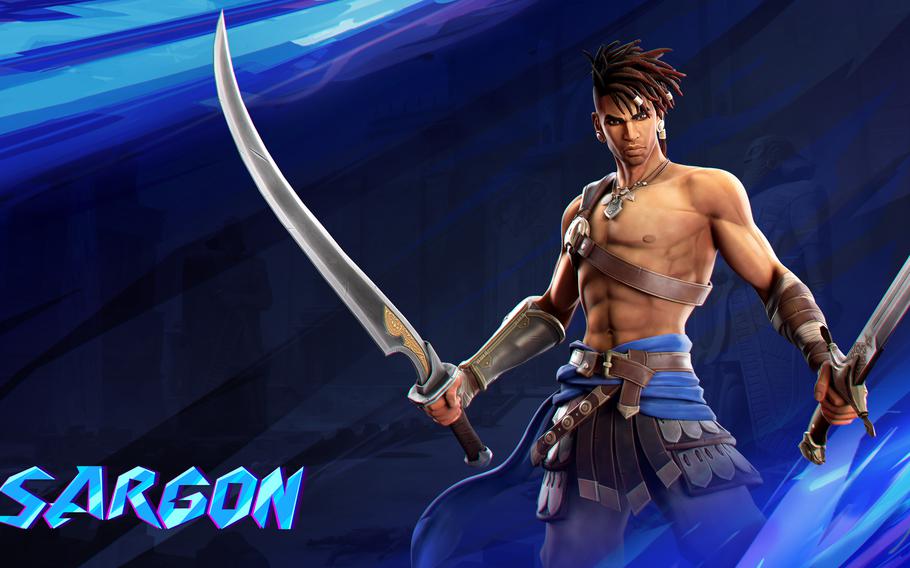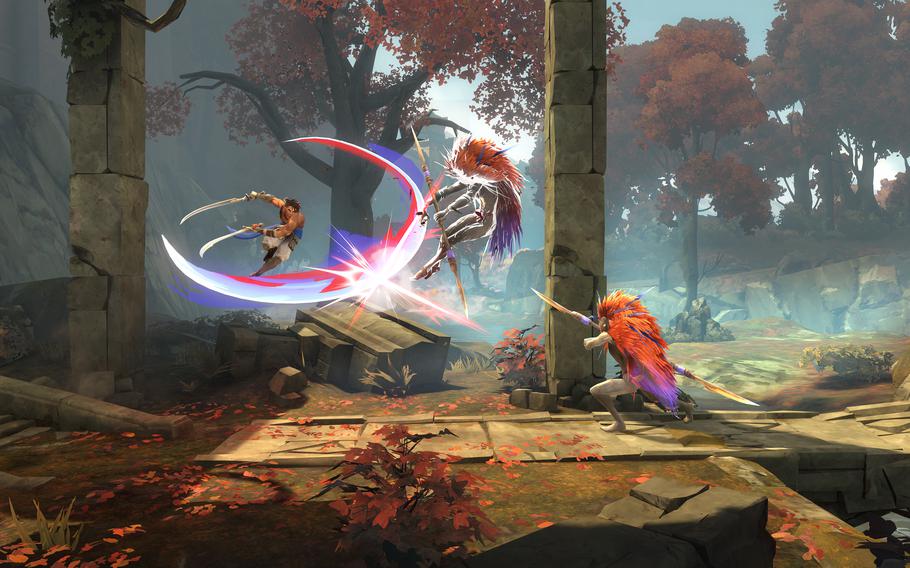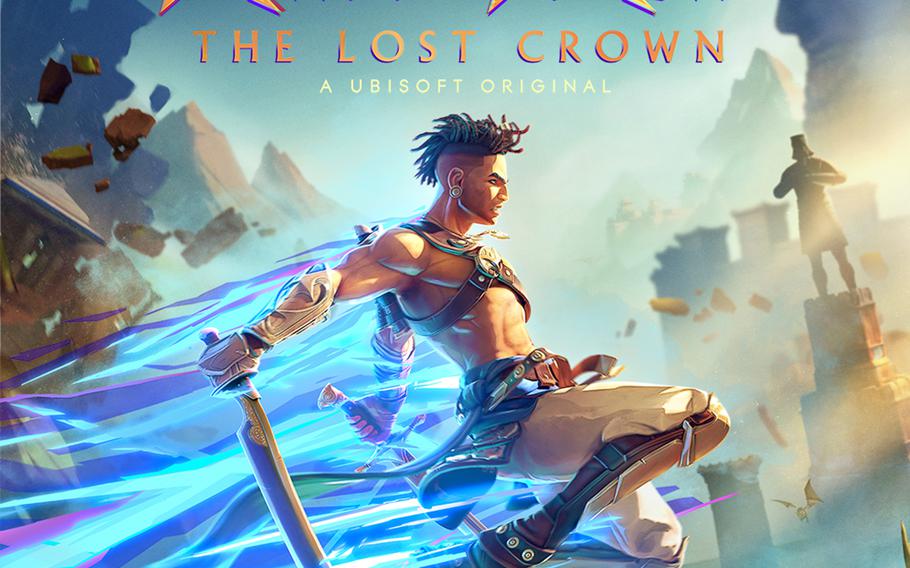
Players will uncover plenty of strange places surrounding Mount Qaf in Prince of Persia: The Lost Crown. (Ubisoft/TNS)
Depending on whom you talk to, mentioning Prince of Persia can bring up two different images. The first is the original title by Jordan Mechner, a 2D classic that seems primitive now but was groundbreaking at the time. The second is the Sands of Time series that features more complex and elaborate gameplay in a three-dimensional world.
Those phases constitute the two main chapters of the series, and Ubisoft is trying to ignite a third. Created by Ubisoft Montpellier, Prince of Persia: The Lost Crown aims to bridge the legacy of those two branches into one game. This entry follows the adventures of Sargon, a gifted warrior among the Immortals.
The elite force works together to defeat General Uvishka of the Kushan empire, which threatened Persepolis. The opening scene and victory offer a glimpse into the seven other Immortals, who play a bigger role in what’s to come. It also reveals a heavy anime-influence in the game’s creation, according to cinematic Lead Joseph-Antoine Clavet. During the celebration, Sargon’s mentor Anahita kidnaps Prince Ghassan. Everyone is flabbergasted by the betrayal, and Queen Thomyris sends her army and the Immortals after her and the prince.
The pursuit leads everyone to Mount Qaf and the ruins of King Darius’ home. Upon entering, the Immortals find that they’re trapped in a place where time works strangely. The army chasing Anahita and Gassan appear to have aged and died. Later in the campaign, more curious deaths occur. The mystery about what happened on Mount Qaf is one of the central story drivers as players control Sargon and chase after the prince to fulfill the primary mission.

Players will find that though they’ll earn new abilities while playing The Lost Crown, they won’t make the campaign easier. (Ubisoft/TNS)
A Metroidvania with ambitions
I jumped into about 3 hours of this 20- to 25-hour game. From the get-go, The Lost Crown follows the Metroidvania style. It’s 2D side-scrolling adventure across a labyrinthine map. Certain sections will be gated off until players acquire a power-up and they continue on with the exploration. There’s a lot to take in, but thankfully, players can take pictures of areas and mark them on a map to remind them to return when they need to backtrack.
The normal course of a Metroidvania campaign is that players acquire a feeling of being more powerful as they earn more upgrades, but with The Lost Crown that isn’t necessarily the case. Players will find that though they’ll earn new abilities that doesn’t make the campaign easier. They won’t mow through enemies.
Ubisoft Montreal infused The Lost Crown with a Team Ninja-esque difficulty when it comes to combat. Being a seasoned warrior, Sargon can swing his swords and perform combos against adversaries, but enemies don’t go down easy. They often aggressively attack or perform unexpected moves.
That means players will have to rely on defensive measures such as a dodge, which is tied to the right trigger, and a block, which is mapped to the left trigger. Players can also parry when timed correctly. Enemies have tells about when to dodge and parry depending on the color. If the attack is yellow, it’s safe to parry. If it’s red, it’s best to dodge.
In addition, players build up a resource called Athra. Once it’s filled up, players can perform a special technique. The two I earned was a strong attack that deals heavy damage and another one that requires a second level that creates an explosion around Sargon but also heals him within a certain field. I quickly learned that you should use meter liberally. There’s no point to hording it, especially during a boss fight.
Lastly, the one weapon I acquired was Menolias’ bow. He’s an Immortal and the bow turns into a chakram that can manipulate gear-requiring mechanisms in the game. The bow also allows for ranged attacks with limited arrows and is key to unlocking one of the first gates in the campaign.

(Ubisoft/TNS)
Upgrading Sargon
Players initially have one potion to fill their limited health, but they can expand that number through merchants. They can also extend the life bar by collecting four Soma Tree petals. The Soma Tree itself is a save point and health restoration spot in the game. Fast travel between the expansive map requires players to unlock Homa Statues.
Lastly, players have an amulet where they can add different charms to boost attack, add health or introduce other perks. Again, it’s another element of customization. The moves echo another newer series – Ori: The Will of the Wisps.
The difference between Lost Crown and Moon Studios’ project is that the combat seems more refined, complex and creative. Battling enemies feels more like Bayonetta, where expert players can dispatch enemies with alarming alacrity. They can block arrows, deal damage, dash away and return for an attack. Players can expertly parry fireballs and follows that up for an extra attack.
The ability to read and react will serve players well especially when it comes to boss fights, which will test players’ skills. In many Metroidvania games, players feel like they plateau, said Joseph-Antoine Clavet, the cinematic lead. In this game, the challenge keeps up with players all the way to the end.
“It’s challenging but fair,” he said. “If you lose, maybe you say my timing needs to better.” The journey of Sargon and the player mirror each other. As players improve their skills, that extends to the protagonist who is also learning to grow into his powers. He doesn’t start off as an exceptionall powerful warrior compared to his peers.
Mind-bending puzzles
But just having quick-twitch reaction to overcome challenging combat and platforming isn’t enough. The Lost Crown will also test players puzzle-solving abilities. I ran into a difficult one, in which I had to use the Chakram to move pillars. The problem is with a single Chakram, I could only move one gear at a time. It took a while to figure out what order to move objects in order to advance.
Clavet said there are more challenging mind-benders later in the game, and I assume that it will only get more difficult as the developers add more powers. One of the missing ones in the preview was the Shadow of Simurgh that lets players cast a marker, move and go back in time to the original spot, destroying enemies in between the two points. That was in the Ubisoft Forward demo, but I assume it would add to the complexity of the puzzles.
Lastly, Ubisoft adds a bit more creativity to the map and enemy design. One foe I ran across was a jailer. It’s essentially an invincible enemy that has a sphere of detection and if you cross it, the foe will chase and try to catch you. If caught, players don’t die. They’re actually thrown in jail and escaping becomes another challenge in and of itself.
On top of that, Mount Qaf is filled with secondary characters and other Immortals. The adventure doesn’t feel like a lonely rescue campaign but a mystery with an ensemble of intriguing heroes. Players will even run into side quests, (Hey, it’s a Ubisoft game after all.) but these missions aren’t distracting and actually go with the flow of exploration.
In my three hours, I felt I just scratched the surface of the narrative and the types of puzzles I would be seeing. When it comes out Jan. 18 on PC, PlayStation 5, PlayStation 4, Xbox One, Xbox Series X and Series S, and Luna, this new entry could mark the start of a new chapter for the longtime franchise, one that holds a lot of promise. Players have a chance to check out a demo Jan. 11.